TOYOTA MIRAI 2021 Accessories, Audio & Navigation (in English)
Manufacturer: TOYOTA, Model Year: 2021, Model line: MIRAI, Model: TOYOTA MIRAI 2021Pages: 344, PDF Size: 12.08 MB
Page 221 of 344
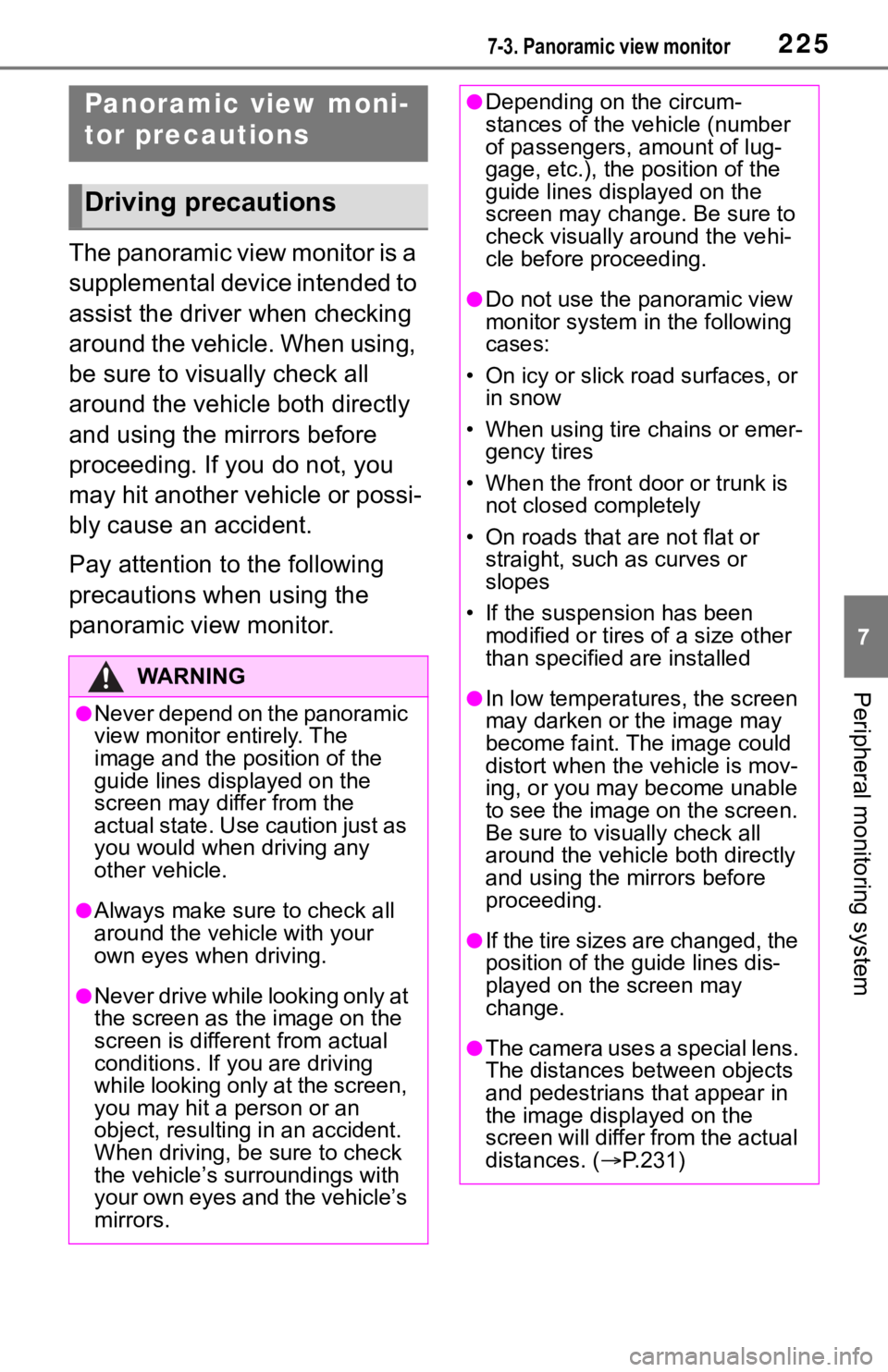
2257-3. Panoramic view monitor
7
Peripheral monitoring system
The panoramic view monitor is a
supplemental device intended to
assist the driver when checking
around the vehicle. When using,
be sure to visually check all
around the vehicle both directly
and using the mirrors before
proceeding. If you do not, you
may hit another vehicle or possi-
bly cause an accident.
Pay attention to the following
precautions when using the
panoramic view monitor.
Panoramic view moni-
tor precautions
Driving precautions
WA R N I N G
●Never depend on the panoramic
view monitor entirely. The
image and the position of the
guide lines displayed on the
screen may differ from the
actual state. Use caution just as
you would when driving any
other vehicle.
●Always make sure to check all
around the vehicle with your
own eyes when driving.
●Never drive while looking only at
the screen as the image on the
screen is different from actual
conditions. If you are driving
while looking only at the screen,
you may hit a person or an
object, resulting in an accident.
When driving, b e sure to check
the vehicle’s su rroundings with
your own eyes and the vehicle’s
mirrors.
●Depending on the circum-
stances of the vehicle (number
of passengers, amount of lug-
gage, etc.), the position of the
guide lines displayed on the
screen may change. Be sure to
check visually around the vehi-
cle before proceeding.
●Do not use the panoramic view
monitor system in the following
cases:
• On icy or slick road surfaces, or in snow
• When using tire chains or emer- gency tires
• When the front door or trunk is not closed completely
• On roads that are not flat or straight, such as curves or
slopes
• If the suspension has been modified or tires of a size other
than specified are installed
●In low temperatures, the screen
may darken or the image may
become faint. The image could
distort when the vehicle is mov-
ing, or you may become unable
to see the image on the screen.
Be sure to visually check all
around the vehicle both directly
and using the mirrors before
proceeding.
●If the tire sizes are changed, the
position of the guide lines dis-
played on the screen may
change.
●The camera uses a special lens.
The distances between objects
and pedestrians that appear in
the image displayed on the
screen will differ from the actual
distances. ( P.231)
Page 222 of 344
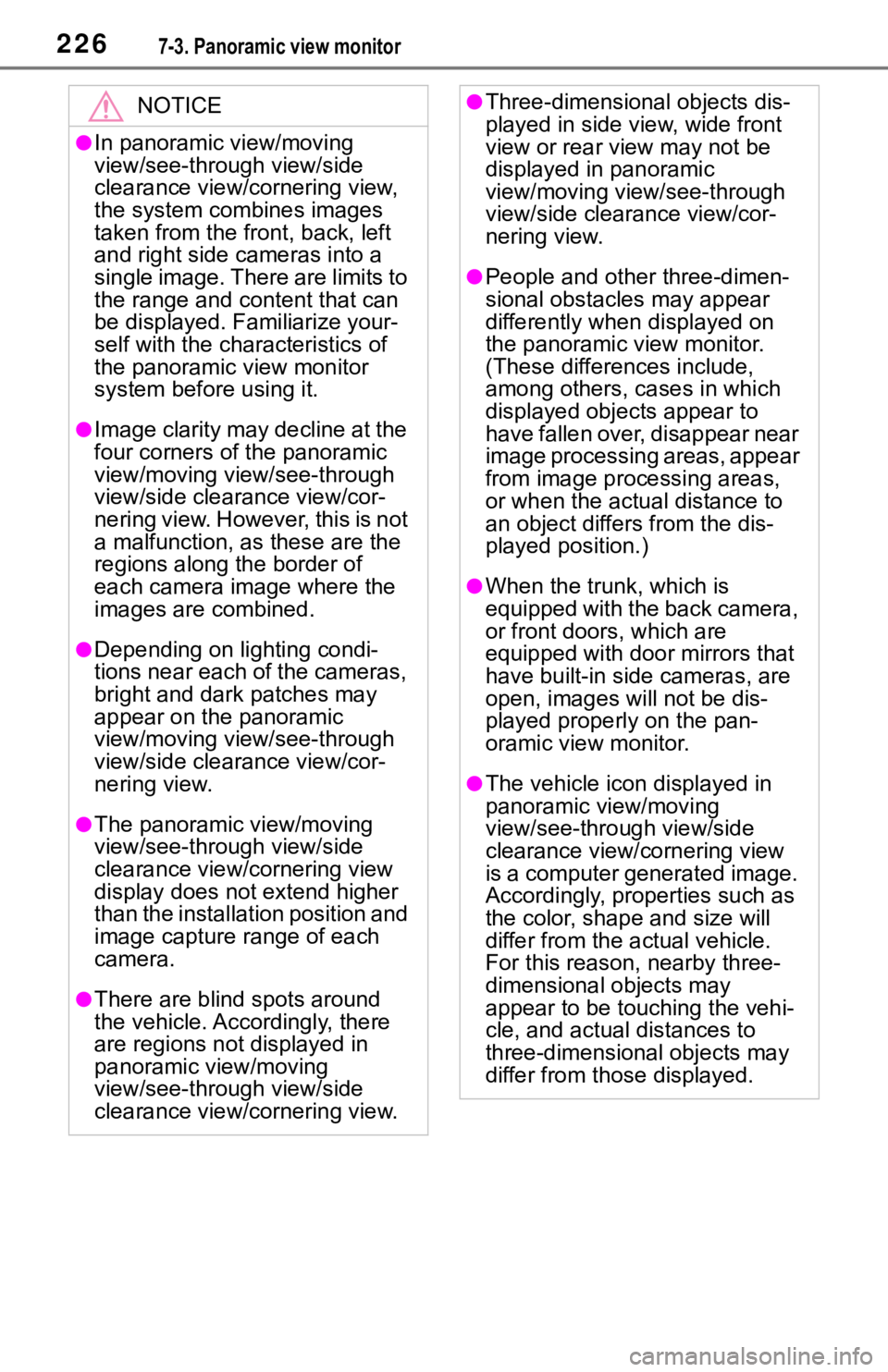
2267-3. Panoramic view monitor
NOTICE
●In panoramic view/moving
view/see-through view/side
clearance view/cornering view,
the system combines images
taken from the front, back, left
and right side cameras into a
single image. There are limits to
the range and content that can
be displayed. Familiarize your-
self with the char acteristics of
the panoramic view monitor
system before using it.
●Image clarity may decline at the
four corners of the panoramic
view/moving view/see-through
view/side clearance view/cor-
nering view. However, this is not
a malfunction, as these are the
regions along the border of
each camera image where the
images are combined.
●Depending on lighting condi-
tions near each of the cameras,
bright and dark patches may
appear on the panoramic
view/moving view/see-through
view/side clearance view/cor-
nering view.
●The panoramic view/moving
view/see-through view/side
clearance view/cornering view
display does not extend higher
than the installation position and
image capture range of each
camera.
●There are blind spots around
the vehicle. Accordingly, there
are regions not displayed in
panoramic view/moving
view/see-through view/side
clearance view/cornering view.
●Three-dimensional objects dis-
played in side view, wide front
view or rear view may not be
displayed in panoramic
view/moving view/see-through
view/side clearance view/cor-
nering view.
●People and oth er three-dimen-
sional obstacles may appear
differently when displayed on
the panoramic view monitor.
(These differences include,
among others, cases in which
displayed objects appear to
have fallen over, disappear near
image processing areas, appear
from image processing areas,
or when the actual distance to
an object differs from the dis-
played position.)
●When the trunk, which is
equipped with the back camera,
or front doors, which are
equipped with door mirrors that
have built-in side cameras, are
open, images will not be dis-
played properly on the pan-
oramic view monitor.
●The vehicle icon displayed in
panoramic view/moving
view/see-through view/side
clearance view/cornering view
is a computer generated image.
Accordingly, properties such as
the color, sh ape and size will
differ from the actual vehicle.
For this reason, nearby three-
dimensional objects may
appear to be touching the vehi-
cle, and actual distances to
three-dimensional objects may
differ from those displayed.
Page 223 of 344
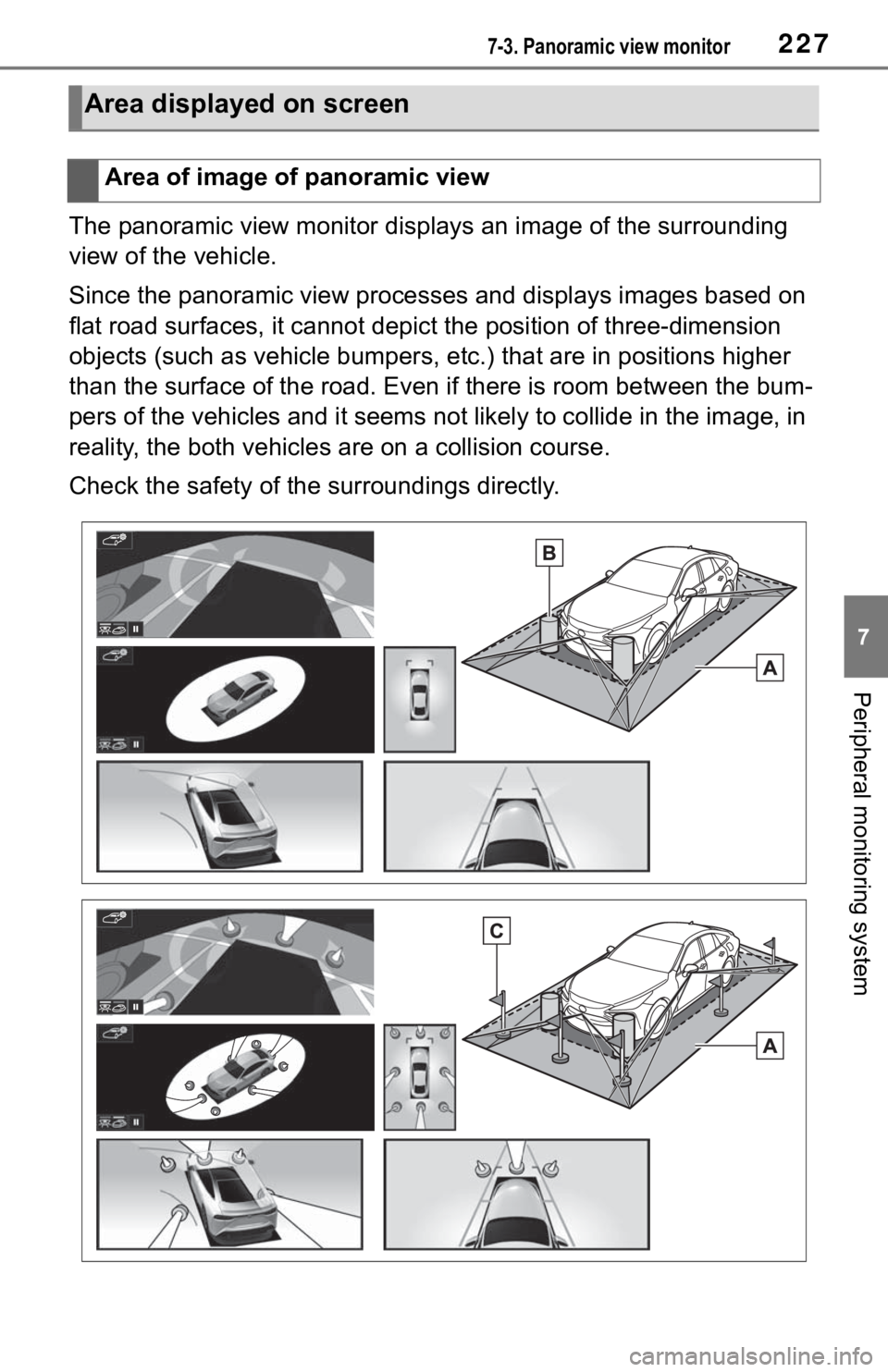
2277-3. Panoramic view monitor
7
Peripheral monitoring system
The panoramic view monitor displays an image of the surrounding
view of the vehicle.
Since the panoramic view processes and displays images based on
flat road surfaces, it cannot depict the position of three-dime nsion
objects (such as vehicle bumpers , etc.) that are in positions higher
than the surface of the road. Even if there is room between the bum-
pers of the vehicles and it seems not likely to collide in the image, in
reality, the both vehicles are on a collision course.
Check the safety of the surroundings directly.
Area displayed on screen
Area of image of panoramic view
Page 224 of 344
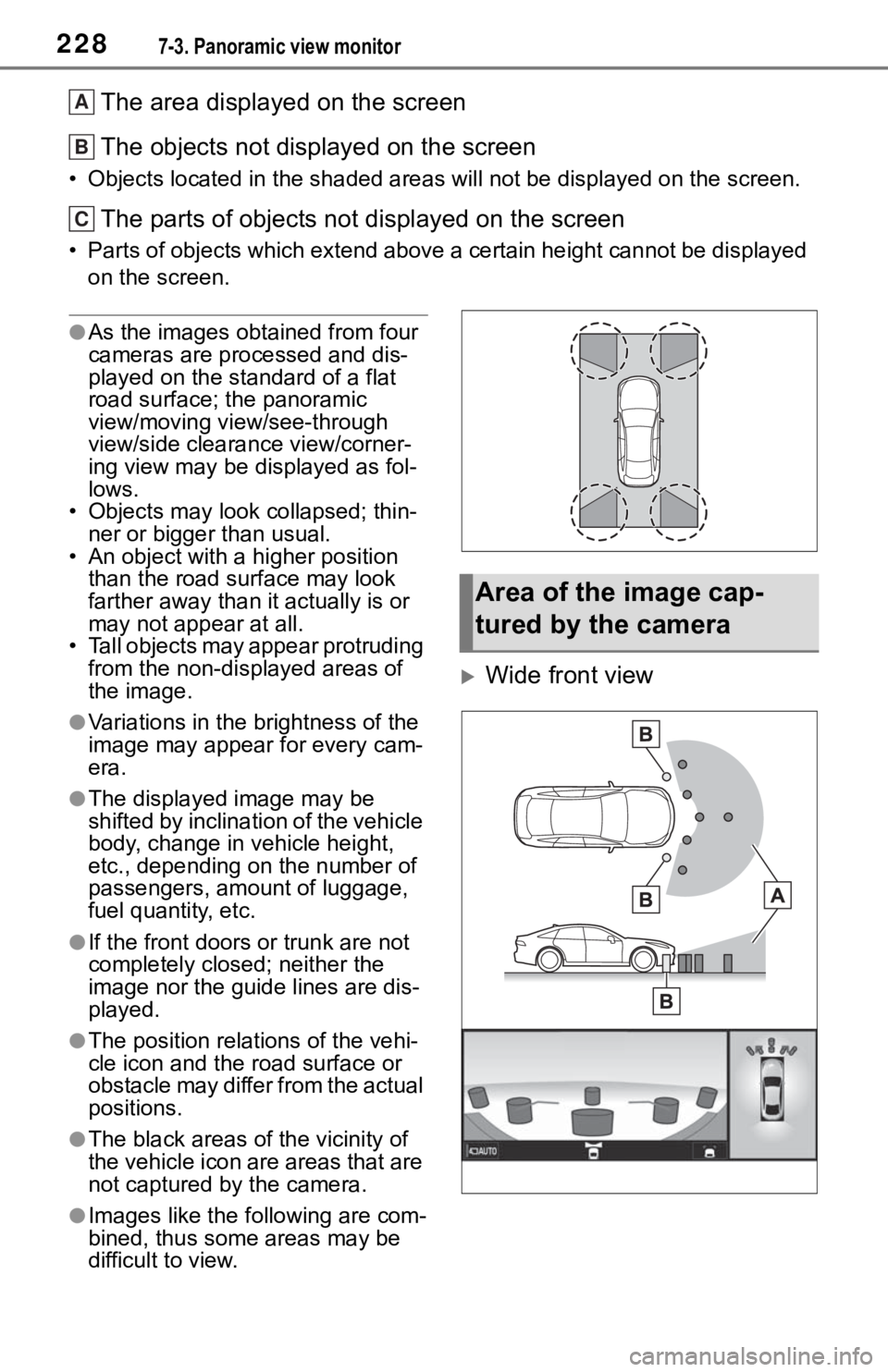
2287-3. Panoramic view monitor
The area displayed on the screen
The objects not displayed on the screen
• Objects located in the shaded areas will not be displayed on t he screen.
The parts of objects not displayed on the screen
• Parts of objects which extend above a certain height cannot be displayed
on the screen.
●As the images obtained from four
cameras are processed and dis-
played on the standard of a flat
road surface; the panoramic
view/moving view/see-through
view/side clearance view/corner-
ing view may be displayed as fol-
lows.
• Objects may look collapsed; thin- ner or bigger than usual.
• An object with a higher position
than the road surface may look
farther away than i t actually is or
may not appear at all.
• Tall objects may appear protruding from the non-displayed areas of
the image.
●Variations in the brightness of the
image may appear for every cam-
era.
●The displayed image may be
shifted by inclination of the vehicle
body, change in vehicle height,
etc., depending on the number of
passengers, amou nt of luggage,
fuel quantity, etc.
●If the front doors or trunk are not
completely closed; neither the
image nor the guide lines are dis-
played.
●The position relations of the vehi-
cle icon and the road surface or
obstacle may differ from the actual
positions.
●The black areas of the vicinity of
the vehicle icon are areas that are
not captured by the camera.
●Images like the fo llowing are com-
bined, thus some areas may be
difficult to view.
Wide front view
A
B
C
Area of the image cap-
tured by the camera
Page 225 of 344
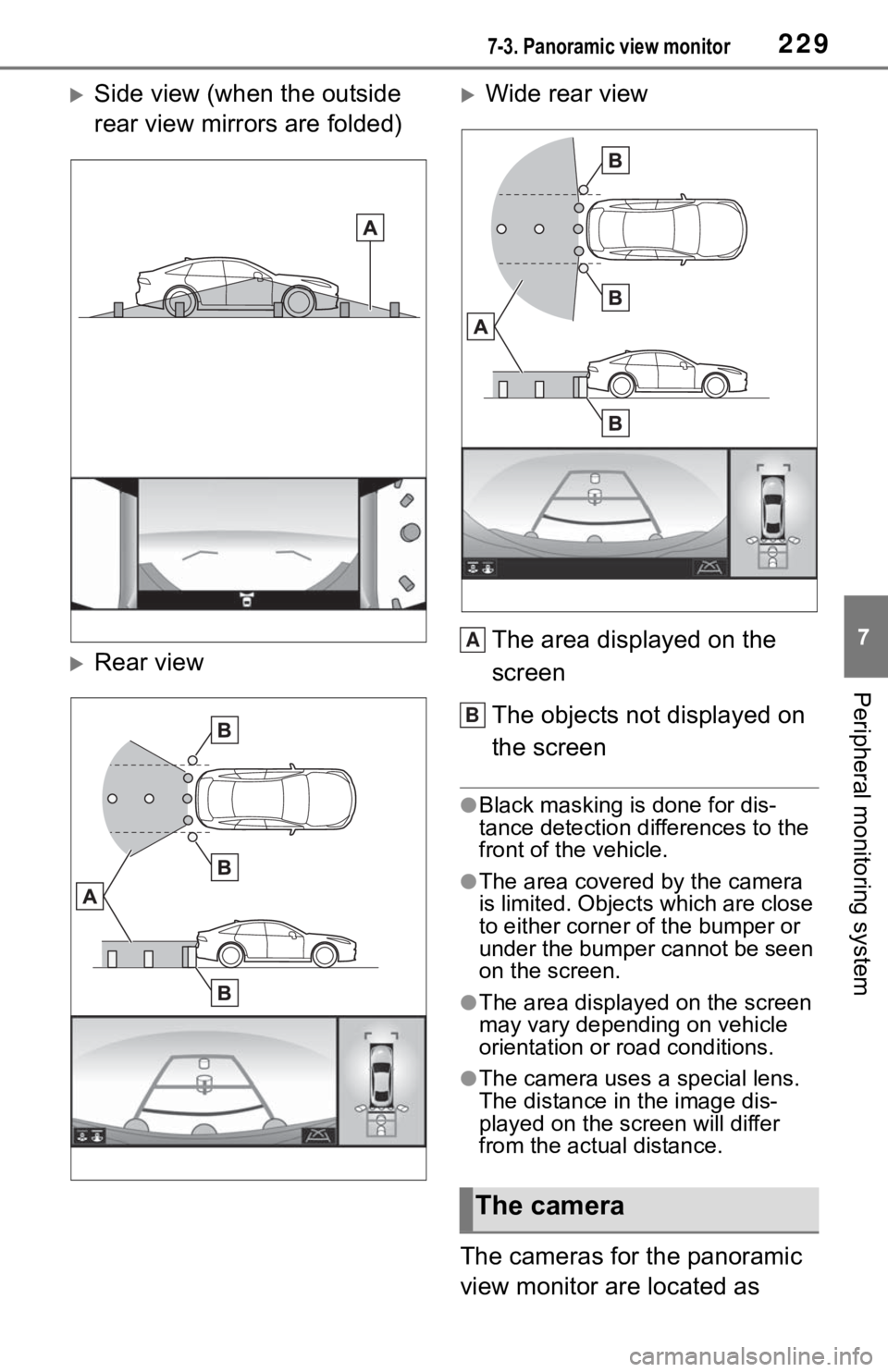
2297-3. Panoramic view monitor
7
Peripheral monitoring system
Side view (when the outside
rear view mirrors are folded)
Rear view
Wide rear viewThe area displayed on the
screen
The objects not displayed on
the screen
●Black masking is done for dis-
tance detection differences to the
front of the vehicle.
●The area covered by the camera
is limited. Objects which are close
to either corner of the bumper or
under the bumper cannot be seen
on the screen.
●The area displayed on the screen
may vary depending on vehicle
orientation or road conditions.
●The camera uses a special lens.
The distance in the image dis-
played on the screen will differ
from the actual distance.
The cameras for the panoramic
view monitor are located as
The camera
A
B
Page 226 of 344
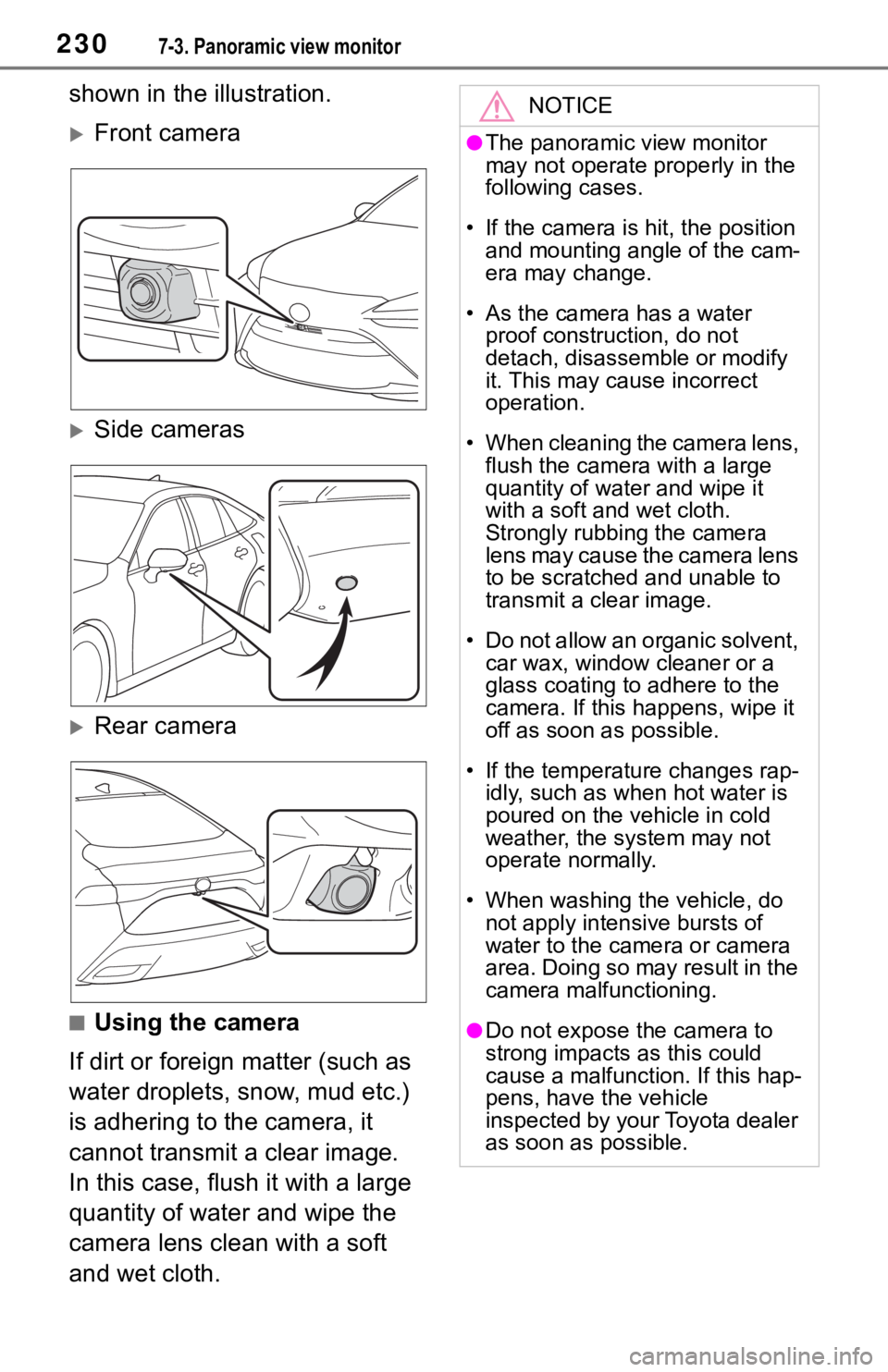
2307-3. Panoramic view monitor
shown in the illustration.
Front camera
Side cameras
Rear camera
■Using the camera
If dirt or foreign matter (such as
water droplets, snow, mud etc.)
is adhering to the camera, it
cannot transmit a clear image.
In this case, flush it with a large
quantity of water and wipe the
camera lens clean with a soft
and wet cloth.
NOTICE
●The panoramic view monitor
may not operate properly in the
following cases.
• If the camera is hit, the position and mounting angle of the cam-
era may change.
• As the camera has a water proof construction, do not
detach, disassemble or modify
it. This may cause incorrect
operation.
• When cleaning the camera lens, flush the camera with a large
quantity of water and wipe it
with a soft and wet cloth.
Strongly rubbing the camera
lens may cause the camera lens
to be scratched and unable to
transmit a clear image.
• Do not allow an organic solvent, car wax, window cleaner or a
glass coating to adhere to the
camera. If this happens, wipe it
off as soon as possible.
• If the temperature changes rap- idly, such as when hot water is
poured on the vehicle in cold
weather, the system may not
operate normally.
• When washing the vehicle, do not apply intensive bursts of
water to the came ra or camera
area. Doing so may result in the
camera malfunctioning.
●Do not expose the camera to
strong impacts as this could
cause a malfunction. If this hap-
pens, have the vehicle
inspected by your Toyota dealer
as soon as possible.
Page 227 of 344
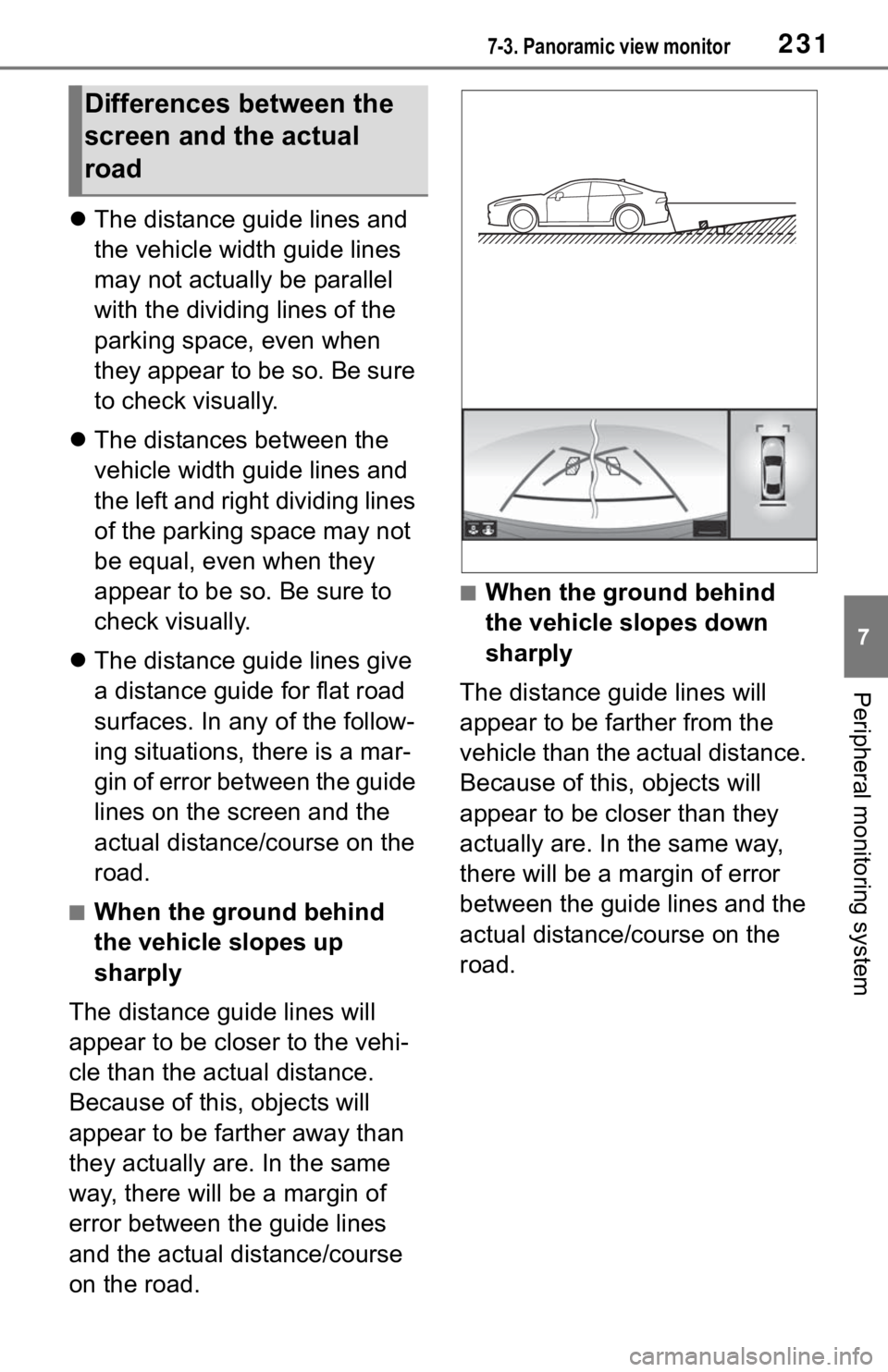
2317-3. Panoramic view monitor
7
Peripheral monitoring system
The distance guide lines and
the vehicle width guide lines
may not actually be parallel
with the dividing lines of the
parking space, even when
they appear to be so. Be sure
to check visually.
The distances between the
vehicle width guide lines and
the left and right dividing lines
of the parking space may not
be equal, even when they
appear to be so. Be sure to
check visually.
The distance guide lines give
a distance guide for flat road
surfaces. In any of the follow-
ing situations, there is a mar-
gin of error between the guide
lines on the screen and the
actual distance/course on the
road.
■When the ground behind
the vehicle slopes up
sharply
The distance guide lines will
appear to be closer to the vehi-
cle than the actual distance.
Because of this , objects will
appear to be farther away than
they actually are. In the same
way, there will be a margin of
error between the guide lines
and the actual distance/course
on the road.
■When the ground behind
the vehicle slopes down
sharply
The distance guide lines will
appear to be farther from the
vehicle than the actual distance.
Because of this, objects will
appear to be closer than they
actually are. In the same way,
there will be a margin of error
between the guide lines and the
actual distance/course on the
road.
Differences between the
screen and the actual
road
Page 228 of 344
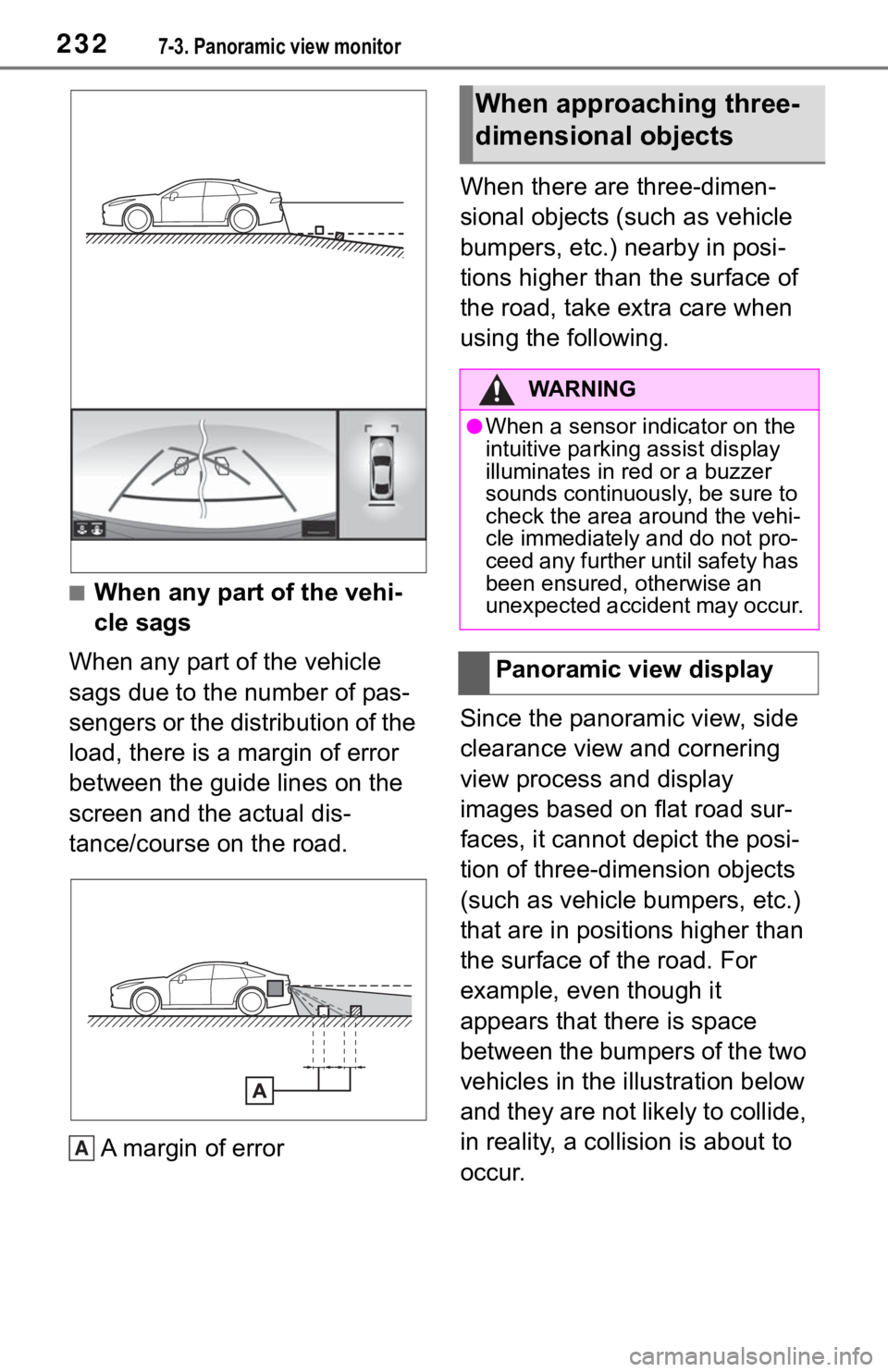
2327-3. Panoramic view monitor
■When any part of the vehi-
cle sags
When any part of the vehicle
sags due to the number of pas-
sengers or the distribution of the
load, there is a margin of error
between the guide lines on the
screen and the actual dis-
tance/course on the road.
A margin of error When there are three-dimen-
sional objects (such as vehicle
bumpers, etc.) nearby in posi-
tions higher than the surface of
the road, take extra care when
using the following.
Since the panoramic view, side
clearance view and cornering
view process and display
images based on flat road sur-
faces, it cannot depict the posi-
tion of three-dimension objects
(such as vehicle bumpers, etc.)
that are in positions higher than
the surface of the road. For
example, even though it
appears that there is space
between the bumpers of the two
vehicles in the illustration below
and they are not likely to collide,
in reality, a collision is about to
occur.
A
When approaching three-
dimensional objects
WA R N I N G
●When a sensor indicator on the
intuitive parking assist display
illuminates in red or a buzzer
sounds continuously, be sure to
check the area around the vehi-
cle immediately and do not pro-
ceed any further until safety has
been ensured, otherwise an
unexpected accident may occur.
Panoramic view display
Page 229 of 344
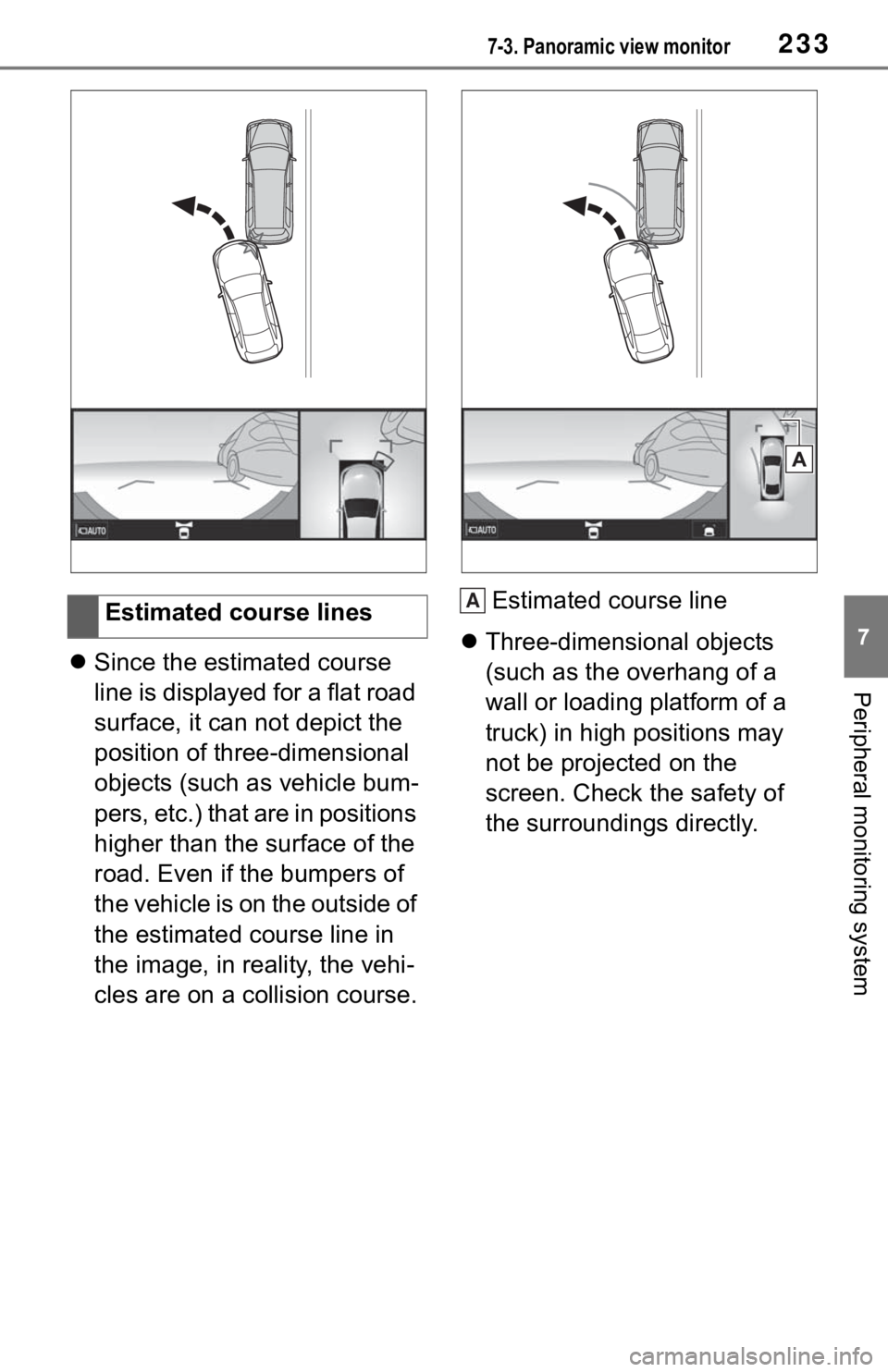
2337-3. Panoramic view monitor
7
Peripheral monitoring systemSince the estimated course
line is displayed for a flat road
surface, it can not depict the
position of three-dimensional
objects (such as vehicle bum-
pers, etc.) that are in positions
higher than the surface of the
road. Even if the bumpers of
the vehicle is on the outside of
the estimated course line in
the image, in reality, the vehi-
cles are on a collision course. Estimated course line
Three-dimensional objects
(such as the overhang of a
wall or loading platform of a
truck) in high positions may
not be projected on the
screen. Check the safety of
the surroundings directly.
Estimated course lines
A
Page 230 of 344
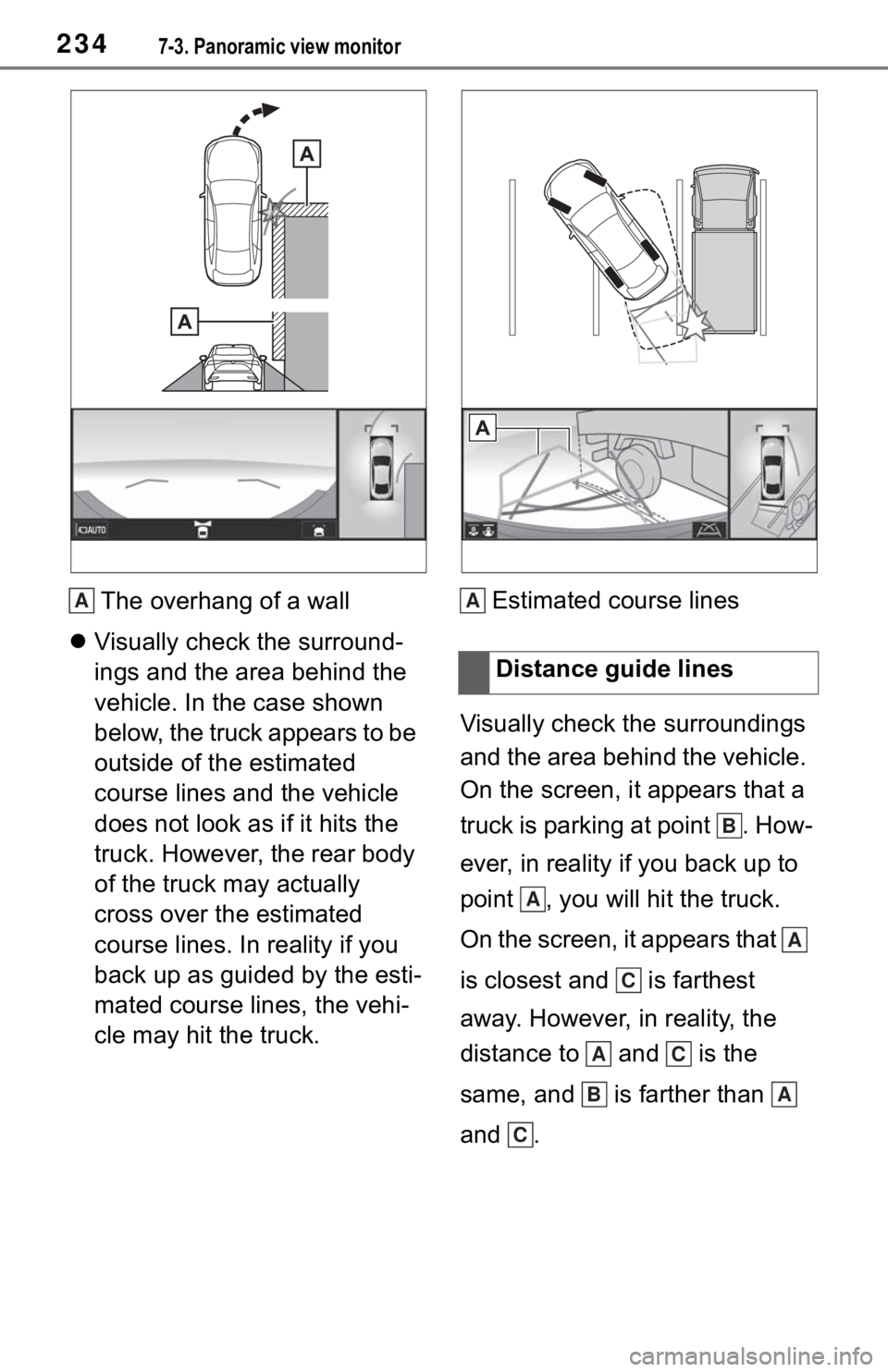
2347-3. Panoramic view monitor
The overhang of a wall
Visually check the surround-
ings and the area behind the
vehicle. In the case shown
below, the truck appears to be
outside of the estimated
course lines and the vehicle
does not look as if it hits the
truck. However, the rear body
of the truck may actually
cross over the estimated
course lines. In reality if you
back up as guided by the esti-
mated course lines, the vehi-
cle may hit the truck. Estimated course lines
Visually check the surroundings
and the area behind the vehicle.
On the screen, it appears that a
truck is parking at point . How-
ever, in reality if you back up to
point , you will hit the truck.
On the screen, it appears that
is closest and is farthest
away. However, in reality, the
distance to and is the
same, and is farther than
and .A
Distance guide lines
A
B
A
A
C
AC
BA
C